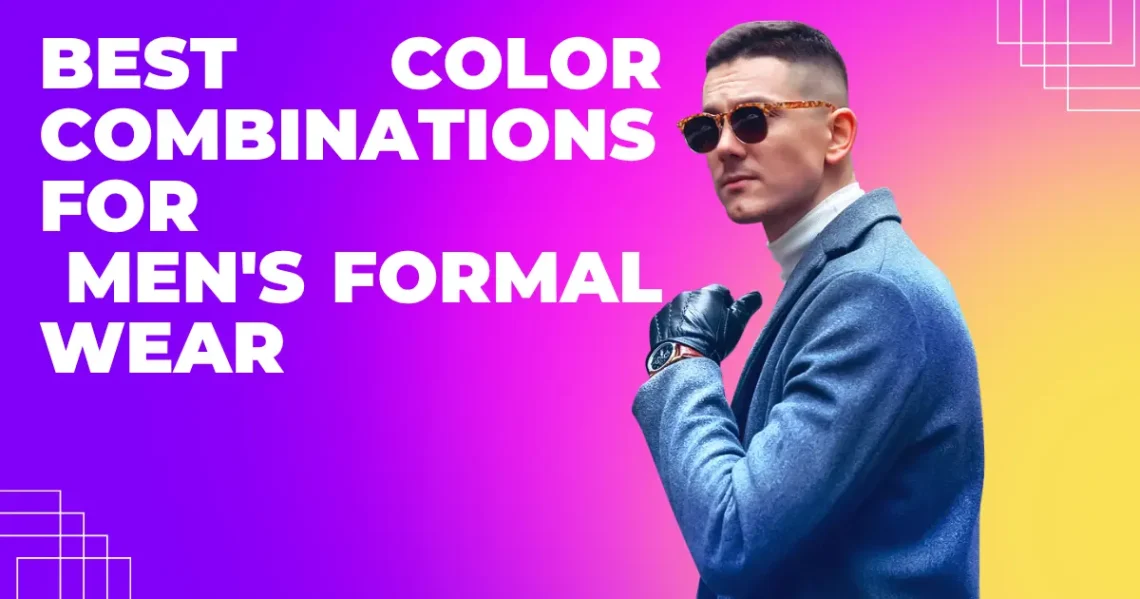Introduction
In men’s formal fashion, looking sharp isn’t just about wearing a well-tailored suit—it’s also about understanding color. The right color combinations can elevate your style, give you a polished look, and help you stand out in the best way possible. Whether you’re heading into a high-stakes meeting, attending a wedding, or just dressing for a typical day at the office, your color choices speak volumes before you even say a word.
Many men stick to basic black-and-white combinations, which are safe but don’t always leave a lasting impression. By learning how to combine different shades and tones correctly, you can add sophistication and personality to your formal wear without being flashy or over-the-top.
This guide is designed to walk you through the best color combinations for men’s formal wear, starting with timeless classics and moving into more modern, stylish options. We’ll also cover essential principles of color coordination, tips on matching shirts and accessories, and even how to dress by season or occasion.
Whether you’re new to formal dressing or looking to update your wardrobe, understanding which colors go well together is key to creating a cohesive and stylish look. This isn’t about following strict rules—it’s about using smart guidelines to build combinations that flatter your skin tone, match the setting, and reflect your personal taste.
Read on to discover the color pairings that never go out of style, the mistakes to avoid, and how to put together formal outfits that feel effortless yet refined.
Understanding Formal Wear Basics
Before diving into color combinations, it’s essential to understand what constitutes men’s formal wear. Formal wear isn’t just about wearing a suit; it’s about dressing appropriately for the occasion while following certain style conventions that reflect elegance and sophistication. Typically, formal wear includes suits, tuxedos, dress shirts, formal trousers, dress shoes, ties or bow ties, and accessories like pocket squares and cufflinks.
The most common types of formal events where this attire is required include business meetings, weddings, galas, interviews, and black-tie events. Each of these settings may have slightly different dress codes, but the underlying principles remain the same: clean lines, quality fabrics, precise tailoring, and harmonious colors.
Traditional formal wear colors include black, navy, gray, and charcoal. These are considered safe, timeless, and versatile. For example, a navy suit is a go-to for business and semi-formal occasions, while a black tuxedo is standard for black-tie events. Charcoal suits provide a serious tone, ideal for professional settings. These base colors serve as the foundation upon which other elements—shirts, ties, shoes, and accessories—are built.
Understanding fabric choices is also part of formal wear basics. Wool is commonly used for suits due to its breathability and structure. For more luxurious occasions, fabrics like velvet, silk, and high-quality cotton may be introduced.
Fit plays a huge role. Even the best color combinations will fall flat if the clothing doesn’t fit properly. A well-fitted suit should follow the contours of your shoulders, hug your torso without pulling, and allow room for natural movement.
With a solid grasp of what defines men’s formal wear, we can now move into the more creative and expressive side of dressing—color combinations that transform your look from standard to standout.
Classic Color Combinations
When it comes to men’s formal wear, classic color combinations are the backbone of timeless style. These are the combinations that have stood the test of time because they are versatile, universally flattering, and appropriate for nearly any formal or semi-formal setting. Mastering these pairings ensures that you always have go-to options that exude confidence and class.
One of the most iconic combinations is the navy suit with a white shirt and brown shoes. This trio is favored for business settings, weddings, and formal gatherings because it strikes the perfect balance between professionalism and modern style. Navy is less harsh than black but still formal, and brown shoes—especially in lighter tones like tan or cognac—add warmth and depth.
Another classic is the charcoal gray suit paired with a light blue shirt and black shoes. This look is especially popular in conservative workplaces or for formal evening events. The gray conveys authority and seriousness, while the light blue shirt softens the overall appearance and introduces a touch of approachability.
Then there’s the timeless black suit, white shirt, and black tie—a staple for black-tie events, funerals, and ultra-formal occasions. While some may view black as overly traditional or even dull, when done correctly with a sharp fit and minimalistic accessories, it can make a strong, elegant statement.
These combinations work because they follow the rule of contrast and cohesion. Darker suits paired with lighter shirts create a natural balance that’s pleasing to the eye. The addition of neutral shoe tones (brown or black) anchors the outfit and provides polish.
Learning these classic combinations gives you a foundation on which to build more adventurous or personalized styles. Next, we’ll explore modern and trendy color pairings that offer a fresher, bolder take on formal menswear.
Modern & Trendy Combinations
As fashion evolves, so does the way men express themselves through formal wear. While classic color combinations will always have their place, modern and trendy pairings offer a way to inject personality, creativity, and a contemporary edge into your look. These combinations reflect current style preferences and are ideal for semi-formal occasions, evening events, or when you simply want to stand out with intention.
One stylish modern option is the burgundy suit with a white or pale pink shirt. Burgundy is rich and sophisticated, offering an alternative to traditional navy or gray. When paired with a white shirt, it maintains a clean look; a pale pink shirt adds subtle contrast and warmth, making it perfect for weddings or upscale dinners.
Another fashionable choice is an olive green suit combined with a cream or beige shirt. Olive is earthy and grounded, yet striking in a formal cut. The cream shirt softens the outfit, making it ideal for outdoor ceremonies or seasonal events in fall or spring. This color pairing is also flattering on a range of skin tones and offers a less conventional but still classy look.
If you want to make a bold yet refined statement, consider a light gray suit with a black shirt and patterned tie. This combination inverts the typical light-on-dark palette and exudes confidence. A black shirt adds depth and attitude, while a subtly patterned tie gives visual interest without overwhelming the look.
Modern color combinations often experiment with tones, textures, and contrasts. The key is balance—too many bold elements can feel chaotic, but with the right pairings, you can remain stylish while pushing boundaries. Accessories, fit, and context still matter just as much.
Seasonal Color Pairings
Seasonal color pairings are a smart way to keep your formal wardrobe feeling fresh, relevant, and visually appealing throughout the year. Just as fabrics shift with the weather—lightweight linens in summer and heavy wool in winter—colors should also adapt to reflect seasonal moods and environments. Aligning your outfit with the season not only shows style awareness but also enhances comfort and appropriateness.
In spring and summer, lighter and softer shades dominate. Think light gray suits, beige or tan blazers, and even powder blue or pale pink shirts. These tones feel airy, modern, and are well-suited for daytime events, garden weddings, or warm-weather office settings. Pairing a light gray suit with a white or sky-blue shirt, and tan or suede shoes creates a crisp and breathable aesthetic. For bolder dressers, suits in pastel tones like mint or lavender can offer a fashionable twist without compromising formality.
In fall and winter, colors become deeper, richer, and more subdued to match the cooler weather and heavier textures. Navy, charcoal, burgundy, forest green, and deep brown are go-to suit colors for these seasons. These tones offer warmth and weight, both visually and practically. Pair a deep navy or maroon suit with a cream, rust, or mustard shirt to introduce complementary tones that feel seasonal without being overpowering.
Seasonal pairings also give you room to experiment with layered textures—think tweed blazers, wool trousers, and knitted ties in the colder months, versus silk ties and linen shirts during warmer ones.
Ultimately, incorporating seasonal colors into your formal wear allows you to express a sense of time, place, and awareness—all while staying appropriately dressed for any occasion. Up next, we’ll look closer at how shirt and tie combinations can refine or transform your entire formal look.
Shirt & Tie Combinations
One of the most impactful ways to enhance your formal wear is through the careful coordination of your shirt and tie. Though often seen as small elements, they are actually central to the overall tone of your outfit. The right shirt and tie combination can bring harmony to your look, while a mismatched pair can throw everything off—even if your suit and shoes are perfect.
The golden rule for pairing shirts and ties is balance. This means considering both color and pattern. Start with the shirt as your foundation. Classic shirt colors like white, light blue, and pale pink offer the most flexibility. These neutral tones work well with a wide variety of ties, whether solid, striped, or patterned.
For a classic and sharp appearance, try a white shirt with a navy or burgundy tie. This pairing works with almost any suit color, especially navy or gray. It’s professional, elegant, and easy to accessorize. A light blue shirt paired with a red or maroon tie creates a striking contrast and works well in business or semi-formal settings.
When working with patterned ties—such as stripes, dots, or paisley—make sure your shirt is either solid or features a subtle, non-competing pattern like a fine check or thin stripe. The key is to avoid overwhelming the eyes with clashing designs.
Color theory also plays a role. Use complementary colors (e.g., blue and orange) for contrast, or analogous colors (e.g., blue and green) for harmony. Always consider your suit color as the backdrop. For instance, a charcoal suit allows for brighter tie choices, while a bold suit like burgundy calls for toned-down accessories.
Shirt and tie combinations are where personal expression can shine. Next, we’ll dive into how accessories can further define your formal style and complete your outfit.
Shirt & Tie Combinations
One of the most impactful ways to enhance your formal wear is through the careful coordination of your shirt and tie. Though often seen as small elements, they are actually central to the overall tone of your outfit. The right shirt and tie combination can bring harmony to your look, while a mismatched pair can throw everything off—even if your suit and shoes are perfect.
The golden rule for pairing shirts and ties is balance. This means considering both color and pattern. Start with the shirt as your foundation. Classic shirt colors like white, light blue, and pale pink offer the most flexibility. These neutral tones work well with a wide variety of ties, whether solid, striped, or patterned.
For a classic and sharp appearance, try a white shirt with a navy or burgundy tie. This pairing works with almost any suit color, especially navy or gray. It’s professional, elegant, and easy to accessorize. A light blue shirt paired with a red or maroon tie creates a striking contrast and works well in business or semi-formal settings.
When working with patterned ties—such as stripes, dots, or paisley—make sure your shirt is either solid or features a subtle, non-competing pattern like a fine check or thin stripe. The key is to avoid overwhelming the eyes with clashing designs.
Color theory also plays a role. Use complementary colors (e.g., blue and orange) for contrast, or analogous colors (e.g., blue and green) for harmony. Always consider your suit color as the backdrop. For instance, a charcoal suit allows for brighter tie choices, while a bold suit like burgundy calls for toned-down accessories.
Shirt and tie combinations are where personal expression can shine. Next, we’ll dive into how accessories can further define your formal style and complete your outfit.
Tips for Choosing the Right Color Combination
Selecting the right color combination for men’s formal wear is both an art and a science. It goes beyond simply matching items—it’s about creating visual balance, projecting the right mood, and enhancing your personal features. Whether you’re new to formal dressing or refining your style, these tips will help you choose color combinations that are both flattering and appropriate.
1. Consider your skin tone.
One of the most overlooked but important factors in color coordination is how different shades interact with your natural complexion. Men with lighter skin tones tend to look better in darker suits with contrast (like navy or charcoal with white or pale blue shirts), while those with medium to dark skin tones can often pull off a wider range of colors, including bold jewel tones like burgundy, forest green, or royal blue. Avoid shades that blend too closely with your skin tone—they may make you appear washed out.
2. Think about the occasion.
Always consider the setting. A classic black suit is best for formal or black-tie events, while a navy or charcoal suit is more versatile for professional or semi-formal settings. If the event is less strict (like a garden wedding or cocktail party), you have room to play with softer or trendier tones like olive, light gray, or beige.
3. Stick to 2–3 main colors.
Limiting your palette keeps your outfit clean and sharp. A good formula: one main suit color, a complementary shirt, and one standout accessory (like a tie or pocket square). Too many competing colors can distract and dilute the elegance.
4. Use the color wheel.
Analogous colors (next to each other) offer subtlety; complementary colors (opposite on the wheel) add contrast. Understanding this basic theory helps you make informed, balanced choices.
Next, we’ll look at some common mistakes to avoid when coordinating colors in formal wear.
FAQs: Best Color Combinations for Men’s Formal Wear
Q1: What is the most versatile suit color for men?
A: Navy blue is widely considered the most versatile suit color. It works in business settings, weddings, semi-formal events, and even some formal occasions. It pairs well with white, light blue, pink shirts, and both brown or black shoes.
Q2: Can I wear brown shoes with a gray suit?
A: Yes. Brown shoes look great with light to medium gray suits. Just ensure the shade of brown complements the formality of the event—darker browns for formal settings, lighter browns or tan for daytime or semi-formal events.
Q3: How do I match my tie with my shirt and suit?
A: Start with a solid base: pick a tie that either contrasts with your shirt or echoes another color in your outfit. For example, with a navy suit and white shirt, a burgundy or deep green tie adds contrast without clashing.
Q4: Are black suits outdated?
A: Not at all—but their use is more limited. Black suits are best suited for formal evening events, funerals, or black-tie settings. For business or daytime occasions, navy or charcoal is often a better, more flexible choice.
Q5: Can I mix patterns in my formal wear?
A: Yes, but with caution. The key is to vary pattern sizes and stick to a cohesive color palette. For instance, a thin-striped shirt can work with a wider-striped or dotted tie if the colors align.
Q6: What colors should I avoid in formal settings?
A: Avoid overly bright or flashy colors like neon or excessive patterns unless the event allows for bold styling. Stick with muted tones and traditional combinations for conservative or corporate environments.
Conclusion:
Choosing the best color combinations for men’s formal wear is essential for creating a polished and professional appearance. From classic pairings like navy and white or charcoal and light blue, to more modern blends such as burgundy with grey or tan with olive, the right color choices can enhance confidence and style. Ultimately, selecting complementary tones that suit your skin tone, occasion, and personal taste will ensure a timeless and sophisticated formal look.





